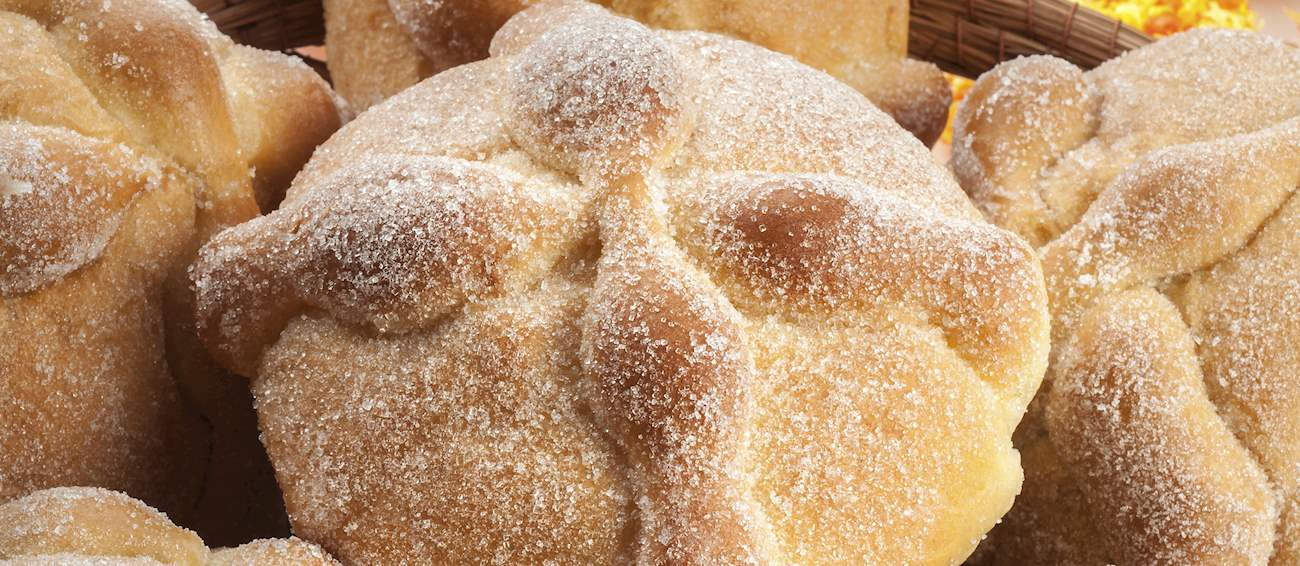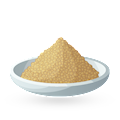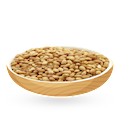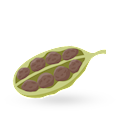MAIN INGREDIENTS
Tsoureki is a traditional Easter bread characterized by its braided shape, which can be either circular or elongated like a loaf. Tradition says that tsoureki should be braided in three strands - one for each aspect of the Trinity. The bread is usually made with milk, eggs, butter, and flavorings such as mahleb, orange zest, cardamom, and vanilla.
After baking, it should be moist, tender, and soft, yet chewy. It is often served with a red-dyed egg on top of it, although it can sometimes be baked together with scarlet-colored eggs, representing the blood of Christ and resurrection. Tsoureki has been prepared in Greece since ancient times, and is traditionally served at the breaking of Lent.
Pan de muerto is a traditional sweet bread that is commonly consumed during the Day of the Dead, celebrated annually on November 2. The bread is characterized by its shape and decorations: a round loaf with strips of dough layered on top of it in order to resemble human bones.
It is made from flour, eggs, milk, butter, sugar, and yeast, and it is traditionally glazed with butter and orange zest on top, then sprinkled with confectioners' sugar. Other flavorings include anise seed and cinnamon. Pan de muerto can also be prepared in other shapes such as skulls, animals, or angels.
Khobz al-Eid al-souri, also known as qalb bread, is a traditional sweet bread made during special occasions like Eid al-Fitr and Eid al-Adha in cities Quneitra, Daraa, and Sweida in Syria. The bread is flavored with anise, black cumin, cinnamon, and fennel, and shaped using a mold.
It is baked during the holidays and enjoyed with family and friends. The dough is enriched with ghee, oil, sugar, and milk, making it soft and sweet.
This baked specialty is a French type of viennoiserie, a cross between a pastry and a bread, with a high butter, milk, and egg content that makes it rich, soft, and flaky. It has been enjoyed for centuries both as a delicacy and as a status symbol.
One popular theory claims that it was invented by Norman Vikings, who settled in France in the 9th century and brought the secrets of making butter with them. The word brioche first appeared in print in 1404, and the name is believed to be derived from bris and hocher, meaning to knead and to stir.
VARIATIONS OF Brioche
MOST ICONIC Brioche
View moreMAIN INGREDIENTS
Vasilopita is a Greek New Year's cake with a coin or a trinket baked inside of it. The cake is enriched with a sweet flavoring, symbolizing the sweetness and joy of life and hope that the New Year will be abundant in health and happiness. Traditionally, the cake is cut by a senior member of the family, and whoever receives the piece with a coin inside is thought to be blessed in the following year.
Each piece is cut in honor of someone or something: the first piece for Jesus Christ, the second for Virgin Mary, and the third for St. Basil, since the cake is named after him. It is believed that St. Basil wanted to give money to the poor, and in order for it not to look like charity, he asked a woman to bake a bread in which he placed several gold coins, so the poor families were pleasantly surprised when they found coins inside the bread.
Usually shaped into a braided loaf, chałka is a soft, sweet Polish bread prepared with a rich yeasted dough. It can occasionally incorporate raisins or other dried fruits and is traditionally sprinkled with sesame or poppy seeds and sliced almonds.
Chałka is derived from the popular Jewish challah bread, but Poles traditionally associate it with Christmas or Easter holidays. Served sliced, it can be enjoyed plain or accompanied with butter and various fruit preserves.
This Venezuelan bread is typically stuffed with raisins, ham, and olives. It is especially popular during the festive Christmas period. The dough is usually made with yeast, flour, butter, eggs, milk, sugar, and salt, resulting in a slightly sweet bread once it has been baked.
After baking, pan de jamón is typically sliced and served with soups or salads. It is believed that this sweet bread was invented in 1905 by Gustavo Ramella, the owner of a bakery in Caracas.
The name of this sweet German bread that translates as snail cake was inspired by its shape since it consists of numerous rolls neatly placed in a pan, whose final shape is reminiscent of snail shells. The base of the bread is prepared with a brioche-like dough that is shaped into rolls.
Each roll usually consists of various fillings such as vanilla-flavored custard, cinnamon butter, fruit, raisins, poppy seeds, or marzipan. When baked, the bread is glazed or dusted with powdered sugar. In Alsace, the dish is better known as chinois.
MAIN INGREDIENTS
Pan de coco is a sweet bread roll filled with desiccated coconut and sugar. Its name can be translated to coconut bread, and it is a very popular snack bread throughout Honduras and the Philippines. The Honduran version uses coconut milk in the preparation of the dough and is usually served with stews, its density making it ideal for soaking up the juices, while the Filipino version is commonly served as a dessert, preferably accompanied by a cup of tea.
Although the origins of this flavorful treat are quite murky, it is believed that the recipe was taken from Central America to Southeast Asia by Spanish settlers in the 17th century.
Kardemommeboller are traditional Swedish cardamom buns. This sweet knotted pastry is usually made with a combination of milk, butter, yeast, sugar, flour, crushed cardamom seeds, and salt. The milk is scalded and mixed with butter until everything is melted.
The combination is mixed with the sugar, salt, cardamom, yeast, and flour in order to make a stiff dough. The dough is left to rise and it's then rolled and folded over into knots. They're baked for a few minutes, then brushed with butter while still hot.
TasteAtlas food rankings are based on the ratings of the TasteAtlas audience, with a series of mechanisms that recognize real users and that ignore bot, nationalist or local patriotic ratings, and give additional value to the ratings of users that the system recognizes as knowledgeable. For the “Top 100 Sweet Breads in the World” list until February 13, 2025, 7,842 ratings were recorded, of which 5,350 were recognized by the system as legitimate. TasteAtlas Rankings should not be seen as the final global conclusion about food. Their purpose is to promote excellent local foods, instill pride in traditional dishes, and arouse curiosity about dishes you haven’t tried.










































































































































